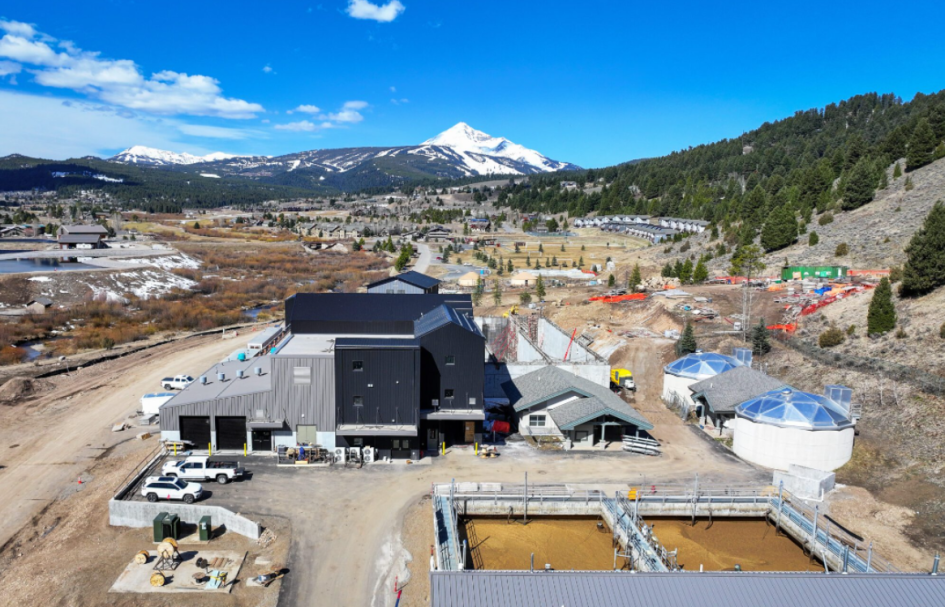Known for its world-class skiing, Big Sky, Montana, also faces infrastructure challenges from its booming tourism industry and growing year-round population. The Big Sky County Water and Sewer District No. 363 (District) owns and operates the wastewater collection and treatment system, which is a full reuse facility, meaning no treated wastewater has ever been discharged to surface or groundwater. This is a long-standing commitment the District made as it sits in the famed Gallatin River watershed. In 2017, surging wastewater needs stretched its aging treatment system to its limits, prompting an ambitious overhaul of its Water Resource Recovery Facility (WRRF).
The District embarked on a transformative upgrade and expansion project to address the region’s rapid growth, ensuring sustainable wastewater treatment and environmental protection for years to come. Guided by the principles of innovation and efficiency, the District partnered with AE2S in 2018 for preliminary and final design engineering, and construction administration. This project is the most significant undertaking in the District’s history, designed to meet both current and future demands for high-level treatment, effluent quality, and full reuse.
“This is the biggest project I’ve ever done in my career,” said Ron Edwards, Big Sky County Water & Sewer General Manager, during the ribbon-cutting ceremony. “Also, one of the best projects I’ve ever done, just from the standpoint of the team we have working on it. Between engineers, contractors, our staff, and my board – they have all been exceptional.”
Growth and Capacity Challenges
Previously designed to process 650,000 gallons per day, the system was rapidly approaching its maximum treatment capacity. To prevent disruptions and maintain environmental standards, the facility expansion will handle 915,000 gallons per day, with future upgrades planned for a capacity of 2.8 million gallons per day on a maximum month basis. This proactive planning and design approach ensures continued development without compromising the area’s natural resources.
Environmental Stewardship
The Gallatin River watershed is a cornerstone of Big Sky’s natural beauty and ecological health. The WRRF upgrades aim to:
- Reduce nitrogen and phosphorus concentrations in the District’s reuse water by over 90%.
- Produce Class A-1 effluent for diverse reuse applications such as irrigation, snowmaking, and potential future groundwater recharge and/or potable reuse.
- Support continued reuse of the District’s biosolids, which are digested and composted to Class A quality for soil amendment.
Innovative Solutions
The new facility integrates advanced membrane bioreactor technology for superior nutrient removal. The membrane technology has 0.04-micron pores, and the combination of upstream biological nutrient removal and what essentially amounts to full solids retainage provides exceptional effluent quality, sets the stage for future reuse projects that will enable the District to uphold its commitment to not discharge to the Gallatin River.
Existing sequencing batch reactor tanks were converted into aerobic digesters and a flow equalization tank, maximizing site efficiency and reuse of existing infrastructure. Additional upgrades include:
- A new headworks building with enhanced screening (dual 6mm and 2mm screens) and grit removal.
- Expanded biosolids handling with increased aerobic digestion capacity.
- An upgraded Instrumentation and Control / Supervisory Control and Data Acquisition system for precise operations.
The new treatment facilities were retrofitted into the District’s existing facility, which had to remain in operation throughout the four-year construction project. This included 1.5 miles of new yard piping to connect the new facilities and processes into existing pipe network.
“Membrane Bioreactor technology was selected due to its smaller footprint and excellent treatment performance, supporting full reuse of the District’s effluent,” explained Scott Buecker, AE2S Wastewater Practice Leader and Project Manager. “This ensures compliance with Montana Department of Environmental Quality reuse water quality standards and sets a foundation for future expansion of the District’s reuse portfolio.”
A Sustainable Future
The WRRF expansion includes capacity for 600 single-family equivalents, in support of providing essential workforce housing. The system’s enhanced reuse capabilities include continued irrigation for three golf courses, and now the addition of snowmaking, reinforcing Big Sky’s long-standing commitment to reuse.
As part of the community’s commitment to environmental stewardship, the District agreed to connect the Gallatin Canyon area to the WRRF via two new lift stations and pipeline projects. This effort will result in hundreds of septic tanks and associated drain fields being taken offline, which should substantially improve groundwater quality and its link to the Gallatin River.
At a total project cost of approximately $60 million, the WRRF upgrade and expansion relied on a mix of funding sources, including a 1% resort tax. The tax covered nearly half of the project’s costs, with the remainder financed through a bond and existing revenue streams. Construction is wrapping up at the end of 2024. The lift station, force main, and effluent pipeline connecting the Canyon Area are estimated at an additional $24 million, and construction is tentatively scheduled to be completed in 2027.
With these upgrades, the District not only addresses immediate wastewater challenges, but also sets a benchmark for sustainable growth and environmental stewardship. This legacy project ensures the region’s natural beauty and economic vitality for generations to come. If you would like to learn more about the project, take a video tour of the District’s WRRF with Scott Buecker and Zach Frieling, AE2S Process Engineer.

